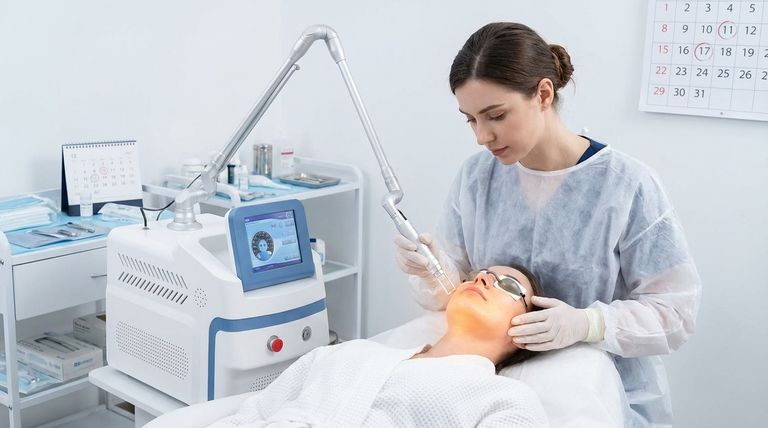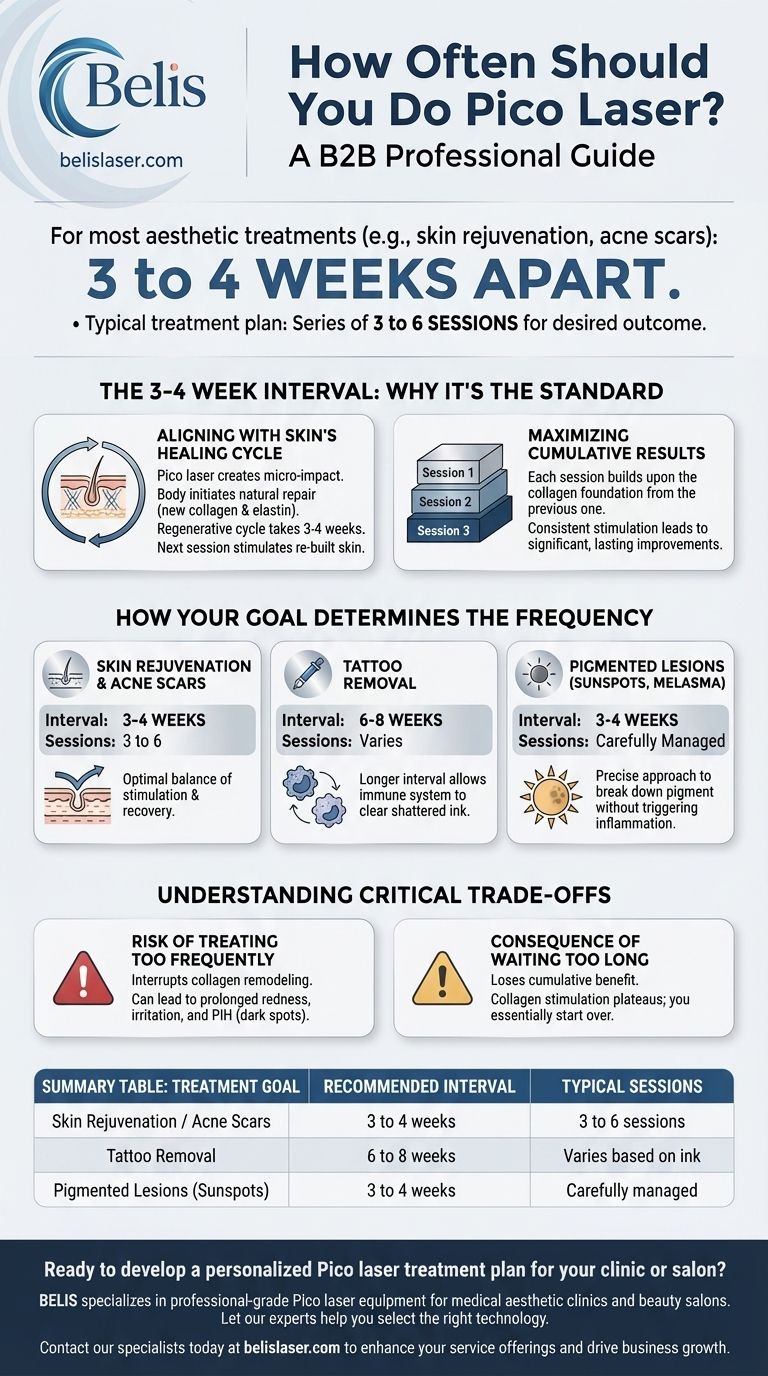For most aesthetic treatments like skin rejuvenation or acne scars, Pico laser sessions are typically scheduled 3 to 4 weeks apart. A complete treatment plan usually consists of a series of 3 to 6 sessions to achieve the desired outcome, as this cadence is designed to work with your skin's natural healing processes.
The crucial factor determining Pico laser frequency is your skin's natural healing cycle. The 3-4 week interval is not arbitrary; it allows your skin to fully recover and produce new collagen, ensuring each session builds effectively on the last for optimal results.

Why the 3-4 Week Interval is the Standard
Understanding the biological reasoning behind the treatment schedule empowers you to make informed decisions. The waiting period is an active and necessary part of the therapy.
Aligning with the Skin's Healing Cycle
A Pico laser works by creating a controlled, micro-impact on the skin. This signals your body to initiate a natural repair process, which includes the production of new collagen and elastin—the proteins responsible for firm, smooth skin.
This entire regenerative cycle takes approximately three to four weeks. Scheduling your next session within this timeframe allows you to stimulate the skin again just as it has finished rebuilding from the previous treatment.
Maximizing Cumulative Results
Pico laser treatments are designed to have a cumulative effect. Each session builds upon the collagen foundation established by the one before it.
Sticking to the recommended schedule ensures that you are consistently stimulating collagen production, leading to more significant and lasting improvements in skin texture, tone, and firmness.
How Your Goal Determines the Frequency
While 3-4 weeks is a reliable baseline, the ideal interval and number of sessions can vary depending on the specific condition being treated.
For Skin Rejuvenation and Acne Scars
This is the most common use case and it adheres strictly to the standard model. A series of 3 to 6 sessions spaced 3-4 weeks apart is typical. This schedule provides the optimal balance of stimulation and recovery for improving texture and reducing scarring.
For Tattoo Removal
Tattoo removal operates on a different principle and requires a longer interval. After the laser shatters the ink particles, your body's immune system needs time to clear them away.
For this reason, sessions for tattoo removal are usually spaced 6 to 8 weeks apart. Rushing this process is ineffective, as the laser can only target ink that your body hasn't yet removed.
For Pigmented Lesions (Sunspots or Melasma)
Treating pigmentation requires a highly precise approach. While the interval is often still 3-4 weeks, the number of sessions and the energy settings used are carefully managed. The goal is to break down pigment without triggering inflammation that could worsen the condition.
Understanding the Critical Trade-offs
Adhering to the correct schedule isn't just about getting the best results—it's also about avoiding potential harm.
The Risk of Treating Too Frequently
Treating the skin before it has fully healed is counterproductive and dangerous. It interrupts the collagen remodeling process and can overwhelm the skin's repair mechanisms.
This can lead to prolonged redness, excessive irritation, and an increased risk of post-inflammatory hyperpigmentation (PIH), where the skin develops dark spots in response to the injury.
The Consequence of Waiting Too Long
If you wait too long between sessions (e.g., several months), you lose the cumulative benefit. The collagen stimulation from the previous session will have plateaued.
While a single session will still offer some benefit, you are essentially starting over each time rather than building progressively toward a more dramatic and lasting result.
Making the Right Choice for Your Goal
Your treatment plan should be a strategic collaboration between you and your provider, tailored to your specific objective.
- If your primary focus is general rejuvenation or acne scars: Plan for a series of treatments spaced 3-4 weeks apart to systematically build collagen.
- If your primary focus is tattoo removal: Expect longer intervals of 6-8 weeks between sessions to give your immune system enough time to clear the shattered ink.
- If your primary focus is managing complex pigmentation: Strictly follow your practitioner's recommended schedule, as incorrect timing can compromise results or worsen the condition.
Ultimately, the correct frequency is a strategic decision that balances stimulating skin renewal with the essential time required for its recovery.
Summary Table:
| Treatment Goal | Recommended Interval | Typical Number of Sessions |
|---|---|---|
| Skin Rejuvenation / Acne Scars | 3 to 4 weeks | 3 to 6 sessions |
| Tattoo Removal | 6 to 8 weeks | Varies based on ink |
| Pigmented Lesions (Sunspots) | 3 to 4 weeks | Carefully managed |
Ready to develop a personalized Pico laser treatment plan for your clinic or salon?
BELIS specializes in providing medical aesthetic clinics and premium beauty salons with professional-grade Pico laser equipment. Our experts can help you select the right technology to offer safe, effective, and profitable treatments to your clients.
Contact our specialists today to learn how our equipment can enhance your service offerings and drive your business growth.
Visual Guide

Related Products
- Pico Picosecond Laser Machine for Tattoo Removal Picosure Pico Laser
- Multifunctional Laser Hair Growth Machine Device for Hair Growth
- 4D 12D HIFU Machine Device for Skin Tightening
- Diode Laser SHR Trilaser Hair Removal Machine for Clinic Use
- Clinic Use IPL SHR ND YAG Laser Hair Removal RF Skin Tightening Machine
People Also Ask
- How does Pico work? Harnessing Ultra-Fast Light for Precise Skin Treatments
- What is the disadvantage of Pico laser treatment? Understand the Risks and Costs Before You Decide
- How much should a Pico laser cost? A Clear Breakdown of Pricing Factors
- What is pico fractional laser good for? Rebuild Your Skin from Within
- How much does it cost to do pico laser? A Clear Breakdown of Pricing Factors



















